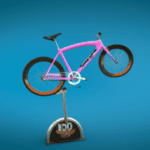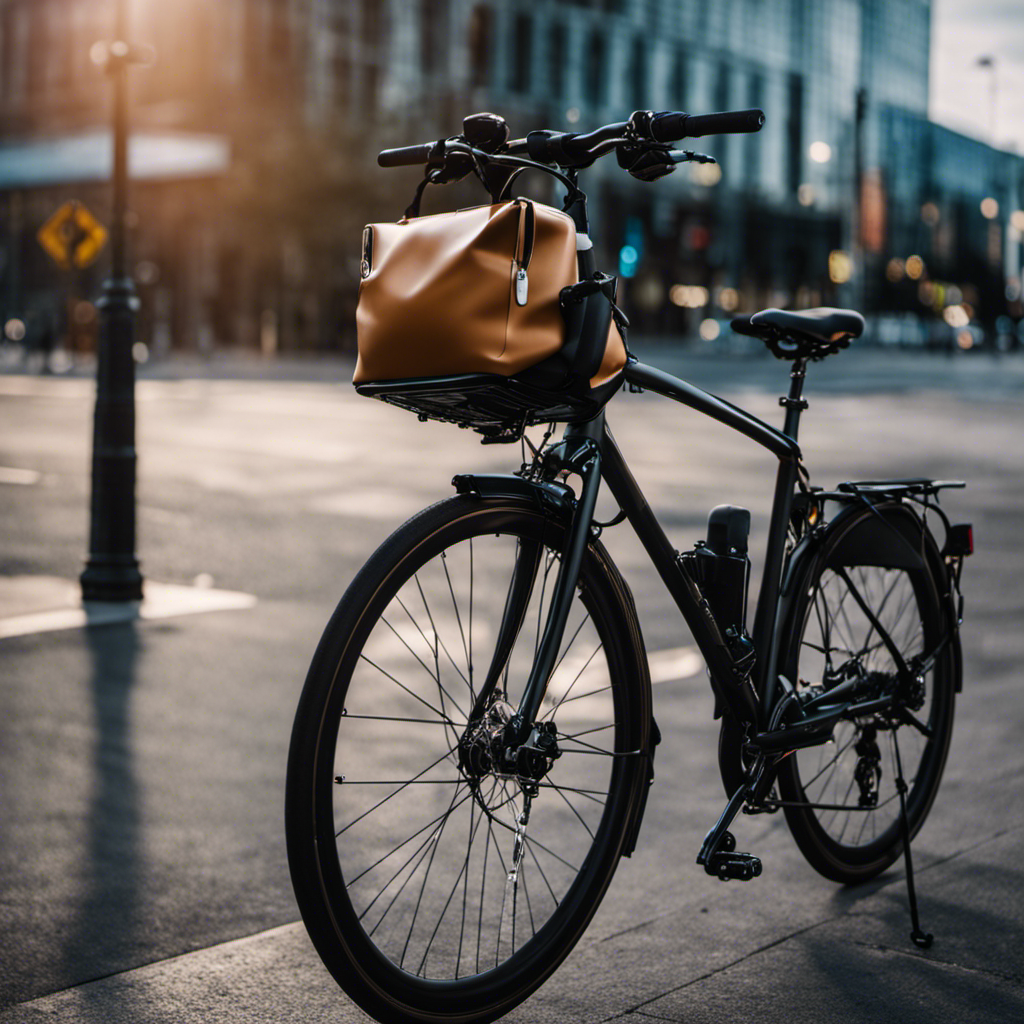Bike weight can dramatically affect your ride. Lighter bikes improve acceleration and climbing efficiency, making your uphill rides feel smoother and faster. You'll notice better responsiveness, especially on technical terrains. However, lighter often means more expensive materials, and the cost-to-performance ratio might not always justify the investment. Plus, a heavier bike can offer more stability and durability, especially on rough roads. For average riders, fitness improvements might deliver greater benefits than weight reduction. By continuing to explore, you'll uncover the best upgrades and strategies to enhance your overall cycling experience.
Key Takeaways
- Lighter bikes enhance climbing efficiency, allowing riders to ascend faster with less power expenditure compared to heavier models.
- Reducing bike weight improves acceleration and responsiveness, making it easier to maneuver on technical terrains.
- While lightweight bikes offer performance benefits, they may come at a significantly higher cost, often not justifiable for average riders.
- Heavier bikes provide better stability and durability, especially in rough conditions, making them suitable for off-road and gravel riding.
- Investing in rider fitness may yield more substantial performance improvements than focusing solely on bike weight reduction.
The Economics of Weight Reduction
When considering the economics of weight reduction in cycling, you'll often find that even small changes can come with big costs. Investing in a lightweight bike often means paying a high cost, especially when it comes to high-end materials designed for ideal strength-to-weight ratios.
For instance, a carbon bottle cage might save you just 30 grams, but at a price of $70, the weight savings can feel underwhelming. Additionally, just as with financial considerations for elderly care, it's important to recognize that the value of performance enhancements can vary greatly depending on individual circumstances and goals.
This cost-to-performance trade-off becomes especially evident with models like the Specialized S-Works, where minimal reductions in bike weight can lead to substantial price increases.
If you're a heavier rider, statistical analysis shows diminishing returns on performance gains from these weight reductions. Instead, improving rider fitness and focusing on body composition might offer more significant benefits for your performance, without the hefty price tag.
Ultimately, the economics of weight reduction can be complex. You'll need to weigh the potential performance gains against the financial investments you're willing to make.
Sometimes, it's smarter to invest in your own fitness rather than solely focusing on achieving the lightest bike possible.
Performance Benefits of Light Bikes

When you ride a lighter bike, you'll notice significant gains in climbing efficiency and acceleration.
The reduced weight not only makes your bike more responsive, but it also boosts your confidence on challenging terrains.
This is akin to the benefits of energy-efficient heat pumps that enhance performance and offer substantial long-term savings.
As you tackle hills and speed up, you'll feel the difference in performance and handling, enhancing your overall riding experience.
Climbing Efficiency Gains
Climbing with a lighter bike can transform your ride by improving efficiency and speed. When you're tackling hills, lighter bikes demand less power, allowing you to maintain higher speeds with lower energy expenditure. A notable weight difference can lead to impressive climbing efficiency gains, especially for lighter riders.
For instance, a reduction of just 10 pounds in bike weight can enhance your climbing performance, while studies show that a 21% increase in bike weight results in a 3.3% decrease in climbing speed for a 95 kg rider.
Additionally, the principles of contrast ratio in projection are analogous to how a bike's weight can affect performance, as both factors greatly influence the overall experience.
Lighter wheels play an essential role in this equation, as they not only improve climbing efficiency but also enhance acceleration and overall bike responsiveness. The benefits are even more pronounced for lighter riders, as heavier cyclists experience diminishing returns on performance gains.
Acceleration and Responsiveness
Acceleration plays a pivotal role in your cycling experience, and lighter bikes excel in this aspect. Each pound of bike weight can require an additional 2-3 pounds of energy to move, making lighter setups markedly more responsive during starts and climbs. For instance, if you're tackling steep gradients, a 10-pound reduction in bike weight can lead to noticeable improvements in climbing efficiency.
Here's a quick breakdown of how bike weight affects performance:
| Weight Reduction | Acceleration Impact | Climbing Efficiency |
|---|---|---|
| 0 lbs | Baseline | Baseline |
| 5 lbs | +10% | +5% |
| 10 lbs | +20% | +10% |
| 15 lbs | +30% | +15% |
| 20 lbs | +40% | +20% |
Upgrading to lighter wheels can enhance acceleration by 110-120%, as rotational weight impacts performance more than stationary weight. Plus, lighter bikes allow for quicker maneuvering, making them ideal for technical terrain where responsiveness is critical. Ultimately, if you want to improve your ride, considering bike weight is essential.
Psychological Confidence Boost
Upgrading to a lighter bike doesn't just enhance performance metrics; it also offers a significant psychological boost for riders. When you hop on a lighter bike, you often feel a newfound sense of agility and responsiveness that can transform your entire ride. This psychological confidence boost may lead you to tackle climbs and technical sections with more determination, as you perceive yourself as faster and more capable, even if the actual performance gains are minimal.
Additionally, just as in sports, focusing on feelings of success can enhance your riding experience, allowing you to embrace each ride with a high vibrational energy that propels you forward positive affirmations.
The lighter weight improves your mental state, allowing for quicker accelerations and easier maneuvering through challenging terrains. With a bike that feels more controllable, you're likely to adopt a more aggressive riding style, making bold decisions that can enhance your overall experience.
This confidence translates into better race times and satisfaction, as you feel empowered to handle any obstacles that come your way.
In essence, the psychological effects of riding lighter bikes can't be underestimated. By feeling more in control and capable, you're not just riding; you're embracing the thrill of the journey, which ultimately enhances your performance on every ride.
Best Upgrades for Weight Savings

When it comes to shedding weight from your bike, focusing on wheel and tire upgrades is your best bet. Upgrading to lighter wheels greatly impacts your ride's acceleration and responsiveness because of their rotational weight.
Carbon wheels, in particular, offer an impressive strength-to-weight ratio and enhanced aerodynamics, providing you with noticeable performance gains. Additionally, just as certain foods can be safe for dogs, like apples, making informed choices about your bike's components guarantees peak performance.
While investing in lightweight components like carbon handlebars or seatposts can lead to some weight savings, the benefits often pale in comparison to the improvements gained from wheels and tires. When you replace heavy stock components with high-end alternatives, you can achieve considerable weight savings, sometimes investing upwards of $1,000.
However, these upgrades can drastically enhance your ride quality and overall performance. It's also essential to prioritize upgrades that balance weight savings with durability.
Opting for reliable tires and wheels guarantees you maintain performance without compromising on longevity, especially on varied terrains. By strategically choosing upgrades, you can transform your bike into a light bike that excels in both speed and handling, allowing you to enjoy every ride to the fullest.
Rider Types and Weight Considerations

As a rider, your weight and fitness level can greatly affect how much you benefit from a lighter bike.
For instance, lighter bikes can provide significant advantages regarding energy-saving features, especially for climbers looking to enhance their acceleration and climbing efficiency.
However, if you're an average rider, focusing on your fitness might yield more noticeable performance gains than worrying about bike weight alone.
Lightweight Benefits for Climbers
Climbers often find that lighter bikes can transform their riding experience, offering considerable advantages on steep ascents. The benefits of reduced bike weight become even more pronounced when tackling hilly terrains, where every ounce counts.
Additionally, choosing the right equipment can impact overall performance and costs, much like the factors influencing home security system costs.
Here are some key advantages of opting for lighter bikes:
- Climbing Efficiency: Lighter bikes require less power from you, leading to improved climbing efficiency and enabling you to tackle steep grades more effectively.
- Acceleration: With a lighter bike, your ability to accelerate quickly is enhanced, allowing you to react swiftly to changing gradients.
- Performance Gains: Research indicates that a 21% increase in bike weight can decrease speed considerably, especially for heavier riders, emphasizing the need for a lighter setup.
- Body Weight Considerations: For lighter riders, the performance gains from reduced bike weight are often more noticeable, while heavier riders may experience diminishing returns.
Average Riders' Priorities
For many average riders, the focus often shifts from the weight of the bike to personal fitness and comfort. While bike weight can play a role, improvements in your body weight and fitness often yield more significant performance gains. Understanding your priorities can help you make better choices.
| Priority | Importance Level |
|---|---|
| Comfort | High |
| Quality Components | High |
| Minor Weight Savings | Low |
For instance, average riders should prioritize a comfortable fit and high-quality components over slight weight reductions. A well-fitted bike with quality parts enhances performance even more than a lighter bike with inferior components.
Additionally, lighter bikes can offer psychological benefits, making you feel more confident on the road. Remember, if you're riding in hilly areas, weight reduction becomes more critical for climbing efficiency, but for most rides, your body weight and fitness level can make a more substantial difference in your overall experience. Ultimately, focusing on comfort and performance should guide your decisions rather than obsessing over bike weight alone.
Terrain's Impact on Performance
Terrain plays an essential role in how bike weight affects your performance. Depending on the terrain type, lighter bikes or heavier bikes can greatly impact your ride.
For instance, just as modern heat pumps are designed for peak efficiency, lighter bikes can offer enhanced performance on varied terrains. Here's a breakdown of how different terrains affect bike weight considerations:
- Hilly Courses: Lighter bikes excel here, enhancing climbing efficiency and acceleration, making your climbs feel easier.
- Flat Terrains: The impact of bike weight diminishes; aerodynamics and rider fitness become more critical than sheer weight.
- Gravel and Off-Road: Heavier bikes can shine due to their durability. Robust components withstand rough conditions better than lighter models, which may sacrifice strength for weight.
- Rider Weight: Heavier riders might experience less performance penalty from added bike weight, as the effect on climbing times is proportionally smaller for them.
Ultimately, the terrain you ride on should guide your choice between lighter and heavier bikes.
Understanding these dynamics can help you enhance your performance and elevate your riding experience, whether you're climbing steep hills or maneuvering rugged trails.
Durability vs. Weight Trade-offs

When choosing a bike, you often face the critical trade-off between durability and weight. Lighter bikes typically use high-quality materials that enhance performance, but this can compromise their durability, especially in challenging off-road riding conditions.
For example, during the Unbound Gravel race, many riders opt for wider tires with puncture protection to maintain control on sharp terrain, showing that durability plays an essential role in performance. Similarly, just as STEM toys support foundational learning and critical thinking, the right bike components can considerably influence your riding experience.
While lighter components can boost acceleration and responsiveness, they often wear out faster than those on a heavy bike, leading to increased maintenance costs over time.
On the other hand, a heavier bike may sacrifice some agility but offers better stability and durability, making it more suitable for demanding riding conditions like mountain biking or gravel racing.
Ultimately, your decision should align with your riding style and intended use. If you're touring or commuting, you might prioritize robustness over minimal weight savings.
Understanding Bike Weight by Type

Bike weight plays an essential role in your overall riding experience, influencing everything from speed to comfort. Depending on the type of bike you choose, the weight can vary considerably, affecting your performance on different terrains.
By leveraging your imagination, you can envision how different bike weights might enhance your riding experience, allowing for profound personal change in how you approach cycling.
Here's a breakdown of bike weights by type:
- Road Bikes: High-end models weigh between 15-17 pounds (6.8-7.7 kg), designed for competitive performance. The UCI minimum weight limit is 6.8 kg (14.99 pounds).
- Gravel Bikes: These typically range from 18-20 pounds (8.1-9 kg) for high-end bikes, while budget options can weigh 22-26 pounds (10-11.8 kg).
- Mountain Bikes: High-end cross-country bikes average 22-24 pounds (10-11 kg), whereas trail bikes may exceed 30 pounds (13.6 kg) for improved stability.
- Weight Distribution: Lighter bikes enhance acceleration and handling, but heavier models offer better stability and comfort on descents.
Your rider preferences will ultimately dictate your choice. If you prioritize average speed and agility, lighter bikes might be your go-to.
However, for durability and performance in challenging conditions, a heavier mountain bike could be the better option.
Cost Implications of Lightweight Bikes

Understanding the cost implications of lightweight bikes is essential for any cyclist looking to enhance their performance without breaking the bank. While lightweight bikes offer notable performance benefits, investing in them often comes with steep price points.
Ultralight models can cost thousands more due to the use of expensive components and advanced materials designed for minimal weight. However, you might find that the financial trade-offs for weight reduction can be significant.
Diminishing returns occur when a minor decrease in bike weight leads to negligible performance improvements relative to the higher costs involved. For instance, upgrading components to achieve substantial weight savings can set you back around $1,000, which may not be justifiable for every cyclist.
Interestingly, investing in losing body weight often yields greater cycling efficiency improvements compared to spending on lightweight bikes. The average weight thresholds for various bike categories highlight the financial trade-offs; lighter bikes, especially those categorized as "Pro racing" under 20 lbs, typically command higher prices.
Ultimately, weighing your options carefully can help you make informed decisions about enhancing your ride without overspending.
Impact of Wheel Weight on Performance

Investing in lightweight components doesn't stop at the frame; wheel weight plays a vital role in your ride's overall performance. Lighter wheels can drastically enhance your biking experience, especially regarding acceleration and climbing efficiency.
Here's how wheel weight impacts your ride:
- Acceleration: Reducing wheel weight markedly improves acceleration. Adding 1 lb of rotational weight feels like adding 2-3 lbs of stationary weight, making lighter wheels more efficient during starts and climbs.
- Responsiveness: Lightweight wheels enhance bike responsiveness, allowing for quicker handling. This is essential in competitive settings or technical terrains where agility matters.
- Climbing Efficiency: A 2-3 lb reduction in wheel weight leads to noticeable performance improvements, especially if you prioritize climbing efficiency.
- Bike Handling: Riders report substantial differences in bike handling with lighter wheels, particularly regarding acceleration and responsiveness during climbs.
Upgrading to lighter wheels not only optimizes performance characteristics like grip and aerodynamics but also transforms your overall ride experience.
If you want to maximize your biking potential, consider focusing on reducing wheel weight.
Frequently Asked Questions
Is a Heavier or Lighter Bike Better?
Choosing between a heavier or lighter bike depends on your riding style. If you prioritize speed and climbing, a lighter bike's agility helps. However, for stability and comfort on descents, a heavier bike's advantages shine through.
Does Weight Affect Riding a Bike?
Absolutely, bike weight affects your ride! For instance, a 21% increase in bike weight can slow you down by 3.3% on climbs. Lighter bikes enhance acceleration, making your rides more enjoyable and less tiring.
Is a Heavier Bike Harder to Ride?
Yes, a heavier bike's harder to ride. You'll struggle more on climbs and feel fatigued quicker. While it offers stability, the extra weight demands more energy, making it challenging to accelerate and navigate tight spaces.
What Are the Disadvantages of Weight Cycling?
Imagine a feather that can't withstand a storm; weight cycling can lead to fragile components, increased maintenance costs, and potential instability. You might find these drawbacks overshadowing the benefits, complicating your riding experience considerably.
Conclusion
In the end, choosing a lighter bike can feel like flying over the pavement—effortless and exhilarating. While the benefits of weight savings are clear, you've got to weigh durability and cost against performance. Whether you're a weekend warrior or a competitive racer, finding the right balance is key. Remember, it's not just about how light your bike is; it's about how it makes you feel when you ride. So, what's your ride going to be?
















